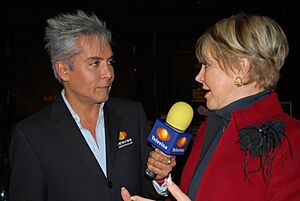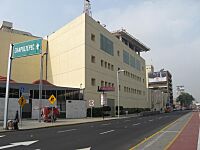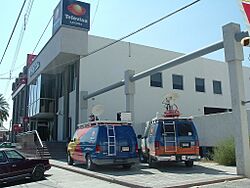Televisa facts for kids
 |
|
|
Trade name
|
Televisa |
|---|---|
| Sociedad Anónima Bursátil | |
| Traded as | BMV: TLEVISA NYSE: TV (ADR) |
| Industry | Mass media |
| Predecessors | Televicentro (1952) Telesistema Mexicano (1955) Televisión Independiente de México (1965) Grupo Televisa (1973) |
| Founded | 8 January 1973 |
| Founder | Emilio Azcárraga Vidaurreta |
| Headquarters | , |
|
Area served
|
Worldwide |
|
Key people
|
Emilio Azcárraga Jean (Chairman) Bernardo Gómez Alfonso de Angoitia (co-CEOs) |
| Products | Broadcasting, cable TV, telecommunications |
| Revenue | |
| Members | Organización de Telecomunicaciones de Iberoamérica |
|
Number of employees
|
42,900 approximate |
| Subsidiaries | TelevisaUnivision (45%) Tritón Comunicaciones Sky México Izzi Bestel |
Grupo Televisa, S.A.B. de C.V., simply known as Televisa, is a Mexican telecommunications and broadcasting company. A major Latin American mass media corporation, it often presents itself as the largest producer of Spanish-language content.
In April 2021, Televisa announced that they would sell the company's media and entertainment assets to Univision Communications, which would form a new company to be known as TelevisaUnivision. The transaction was completed on January 31, 2022, with Televisa owning a 45% stake of the company.
Company
History
Since its beginning, the company has been owned by the Azcárraga family. The company has been led and owned by three generations of Azcárraga; each has marked an era for the company and, until October 2017, each had passed the ownership of the company to his son upon his death.
Emilio Azcárraga Vidaurreta (1955–1972)
Grupo Televisa was founded in 1955 as Telesistema Mexicano, linking Mexico's first three television stations: XHTV-TV (founded in 1950), XEW-TV (1951) and XHGC-TV (1952). Along with Emilio Azcárraga Vidaurreta, the O'Farril family and Ernesto Barrientos Reyes, who had signed on Mexico's first radio station, XEW-AM, in 1930, were co-owners of the firm. Its headquarters, known as Televicentro, were originally located on Avenida Chapultepec in downtown Mexico City. The building opened on 10 February 1952.
The channel was the first national network to be broadcast in color in 1963. Before the launch, Telesistema began airing in color in the late 1950s in select cities along the U.S.-Mexico border, given the fact that color signals were already present since the start of US color television in the decade starting from 1954.
In 1968, Telesistema's main competitor, Televisión Independiente de México (TIM), entered Mexico City with XHTM-TV Canal 8. At the time, both Telesistema and TIM (which was based in Monterrey) competed with another new station, XHDF-TV channel 13, which also started transmissions in 1968. Over the next four years, both networks competed in content and image until they merged, taking on the name "Televisa" in 1973. In the merger deal, the owners of Telesistema had 75 percent of the stocks, while the owners of Televisión Independiente had the rest, which were sold to Telesistema later because of financial problems.
On 7 September 1970, 24 Horas debuted and became one of Mexico's most-watched news programs. The host, journalist Jacobo Zabludovsky, anchored the newscast for almost three decades.
The 1973 merger brought in another new face who would later help revolutionize television and pop music: Raúl Velasco and his Sunday program Siempre en Domingo, which was, from the start, being aired on Telesistema. Its successful run of 29 seasons (1969–98) not only featured the best pop artists from Spain and Latin America as well as from English-speaking countries, but also the most successful local singers, and its broadcast into many countries in both North and South America helped promote Latin pop to millions of television viewers.
Emilio Azcárraga Milmo (1972–1997)
On 17 August 1972, Emilio Azcárraga Vidaurreta died, and Emilio Azcárraga Milmo succeeded him as company president and owner. On 8 January 1973, both Telesistema Mexicano and Televisión Independiente de México merged, taking on the name Televisa, an acronym for Televisión Via Satélite in Spanish. In 1975, brothers Emilio Diez Barroso and Fernando Diez Barroso began working in the presidency offices of Televisa.
Televisa started to transmit several programs produced by the Universidad Nacional Autónoma de México in 1977. On 3 March 1983, Channel 8 was reformatted to become a cultural channel, offering informative programs, debates and cultural shows. In 1985, a frequency swap moved the station from channel 8 to 9, and Televisa also decided to swap its callsign for that of XEQ-TV, which had been on channel 9 and broadcast from Altzomoni; the XHTM callsign was moved to that station, which was moved to channel 10. Canal 9 eventually became Galavisión, now known as Gala TV.
On 19 September 1985, an earthquake measuring 8.1 on the Richter scale caused widespread damage in Mexico City and destroyed the south tower of Televisa's main building. Nonetheless, Televisa's transmissions were not seriously affected. However, several dubbed TV shows were lost.
In 1991, Televisa, with help from Japanese public television network NHK (Nippon Hōsō Kyōkai), began its first broadcast in HDTV, using the Japanese Multiple sub-Nyquist sampling Encoding MUSE system, the first in Latin America. Between 1993 and 1994 Televisa was about to buy Italian local TV station GBR, based in Rome, planning to import in Italy the network's mixed sport-telenovelas formula, but the transaction was ultimately aborted.
It was Azcárraga Milmo who presided over the launch of company owned Noticias ECO in 1988, which was the first Spanish language cable and satellite news network in Latin America.
Emilio Azcárraga Jean (1997–2017)
In April 1997, Milmo died and Emilio Azcárraga Jean succeeded him as the president of the company. Azcárraga Jean was 29 years old and he was one of the youngest executives in Mexico at that time. In December 1997, Televisa joined with other Mexican media companies to create a marathon known as Teletón, whose mission is to provide knowledge about physical disabilities, giving a strong message about respect, equality and support to people in these conditions. This movement from media, enterprises and Mexicans is reflected in the buildings created with the money from this Marathon, named Centros de Rehabilitación Infantil (CRIT). It is said that sponsors use it as a way to deduce taxes as the Teletón takes place at the end of the fiscal year and therefore allows companies to deduce their donations before declaring their incomes. Televisa introduced a new logo on January 1, 2001, putting eight lines instead of ten, and it closely resembles the previous logo. Changes include the sun now being a 3D ball, which in turn making the logo an eye, and the wordmark was brought back and in Helvetica Black.
Televisa is the largest mass media company in Latin America, and it is owned by the Azcárraga family. Televisa controls 66% of the 465 television concessions. Also Televisa owns television programing and broadcasting, programing pay television, publishing distribution, cable television, radio production and broadcasting, football teams (Club Necaxa and Club America), stadiums, Televisa editorial (that makes books, newspapers and magazines), paging services, professional sports and business promotion, film production and distribution, dubbing, operation of horizontal internet portal, DVD distribution, EMI Televisa music, Playcity casino, etc.
There is complicity between Mexican media and government. Media and political power in México have a symbiotic relationship where the economic elites that control the media (Televisa and TV Azteca) are privileged in exchange for their support for the policies and actions of the government. In México the mass media owners are likely to have access to high levels of the Mexican government. On 3 May 2006, the community of San Salvador Atenco was violently repressed by the Mexican police who used excessive force and committed severe human rights violations. This event was one of the most violent repressions in the nation's history. This event is important because it shows how Televisa and TV Azteca were involved in inciting and supporting the repression of the people of Atenco by the government in México. The approval of the repression of Atenco by TV Azteca and Televisa can be seen as a clear example of the collaboration between mass media and government. Televisa and TV Azteca through their news programs support government policies without criticism and dismiss alternative voices to the dominant discourse. When this event occurred, mass media portrayed the farmers of Atenco as a radical social movement without reporting the reason behind the mobilization. In México the mass media are not there to provide objective information, México is under the shadow of authoritative journalism, in which they are only there to endorse an agenda that is aligned with the government.
In August 2014, Televisa announced it would acquire the remaining shares in Mexican cable firm Cablecom that it did not already own for a fee of around $653.96 million. In September 2014, it was announced that Grupo Salinas would acquire Grupo Televisa's 50 percent stake in Mexico's third largest wireless operator Iusacell for a fee of $717 million. In January 2016, Televisa introduced a new branding, including a new logo design: an updated version of the company's logo from 1973, and a new slogan "Tu companía, tu más".
Post-Azcárraga family leadership; sale of content assets to Univision and spin-off of gambling, publishing and sports assets (2017–present)
Emilio Azcárraga Jean renounced the leadership of Televisa in October 2017, although he remains chairman of the company's board of directors. The newly appointed leader of the company will be the first not to be part of the Azcarraga family. The move was made to combat the massive decline in Televisa's viewership created by the rise in popularity of Netflix and other video streaming services, becoming more popular than cable television, as well as the end of the duopoly of private channels caused by the arrival of new players in the 2010s.
On April 13, 2021, Televisa announced that it would sell its content assets to its longtime U.S. partner, Univision Communications which it would combine Televisa's four free-to-air television networks in Mexico, specialty channels, its Videocine film studio, and the Televisa trademark; with Univision's broadcast networks and specialty channels, radio, and digital assets. The merger was targeted to be completed by the end of that year, subject to U.S. and Mexican regulatory reviews, and the new company would be known as TelevisaUnivision. Televisa would own 45% of the combined company and would retain its shares in Club America football team, telecommunication company Izzi Telecom, satellite TV provider Sky Mexico, and publishing businesses, as well as the broadcast licenses for free-to-air TV stations within Mexico and other infrastructure for the company's four TV networks; the national and local TV news operations were spun off into Tritón Comunicaciones.
The sale was approved by Mexico's Federal Telecommunications Institute (IFT) on September 15, 2021. The merger was approved by American Federal Communications Commission (FCC) on January 24, 2022, while the sale was completed on January 31 of that same year.
In 2023, Televisa announced plans to spin-off its gambling and sports operations as a separate company. The company was named Ollamani and the spin-off was completed on February 20, 2024.
In 2024, Televisa acquired AT&T's controlling stake in Sky México.
Properties and services
Properties or partial properties
Televisa is the second-largest media conglomerate in Latin America behind Grupo Globo, with interests in television broadcasting, programming for pay television, international distribution of television programming, direct-to-home satellite services, publishing and publishing distribution, cable television, radio production and broadcasting, professional sports and show business promotions, paging services, feature film production and distribution, dubbing, and the operation of a horizontal Internet portal. TelevisaUnivision Mexico's telenovelas generally run only one season and are broadcast internationally. The conglomerate has partially to complete interest in the following companies:
Telecommunications and pay-television industry
- Cable providers
- Izzi Telecom (formerly known as Cablevisión México) is the internet, fixed telephony and cable TV provider of Grupo Televisa. The company is made of several formerly separate companies (Cablevisión DF, Cablemas, Cablevisión Monterrey, Cablecom and Telecable) combined to provide competition against Telmex.
- Sky México
Publishing (books, magazines and newspapers)
- Editorial Televisa
- Vanidades
- TVyNovelas
- Rolling Stone Mexico
- Muy Interesante (Mexico)
- Intermex (Editorial house)
Websites
- Comercio Más (Internet EsMas.com)
- Televisa Digital (Internet)
- N+ LIVE
Studios
- Televisa Chapultepec
- Televisa San Ángel
- Televisa Santa Fe
- Televisa Guadalajara
- Televisa Monterrey
- Televisa Puebla
Other
- Fundación Televisa
- Más Fondos (Investment Group)
- Volaris (Airline) (Sold on 16 July 2010)
- Playcity Casino (Gambling)
- Multijuegos (Lotto)
Media networks
Televisa is the largest shareholder of TelevisaUnivision, which provides programming throughout Mexico through four networks via Las Estrellas, Foro, Canal 5 and Nu9ve, and in the United States via Univision and UniMás through local affiliates. 253 Mexican local television stations (54.8% of the total commercial stations), and 59 US local television stations air programming from all six terrestrial networks.
TelevisaUnivision also operates a subsidiary called Televisa Networks (it's still often recognized within the entertainment industry by its previous moniker, Visat). This subsidiary is responsible for the distribution of Televisa programmes by satellite. The company also distributes the international feed of Las Estrellas via satellite to Latin America, Europe, Australia, and New Zealand.
Programming
Partnerships with other television networks
Televisa and Univision
Televisa has an ongoing relation with the US-based Univision network, dating back to the 1960s, when Univision's predecessor, the Spanish International Network (SIN), was owned by Telesistema Mexicano, Televisa's predecessor.
In October 2010, Televisa agreed to take a 5% stake in Univision and to extend and expand the companies' long-term program license agreement. The new program license agreement will include Internet and mobile rights and cover key Mexican football (soccer) rights and will run through at least 2020.
Televisa and Telemundo
On 18 March 2008, Televisa and NBCUniversal announced a 10-year multiplatform agreement that would allow 1,000 hours of Telemundo programming from news, entertainment programs, specials, and sports to be broadcast over not only its Galavision channel (XEQ-TV), but also its SKY Channel and Cablevision cable system starting in April, as well as a planned Telemundo pay TV channel to be launched later in 2008.
Televisa's uncompleted agreement to acquire a stake in Nextel Mexico
In January 2010, Televisa announced an offer to acquire a 30% stake in Nextel Mexico from NII Holdings for US$1.44 billion. However, they later terminated the agreement.
Logos
See also
 In Spanish: Televisa para niños
In Spanish: Televisa para niños









